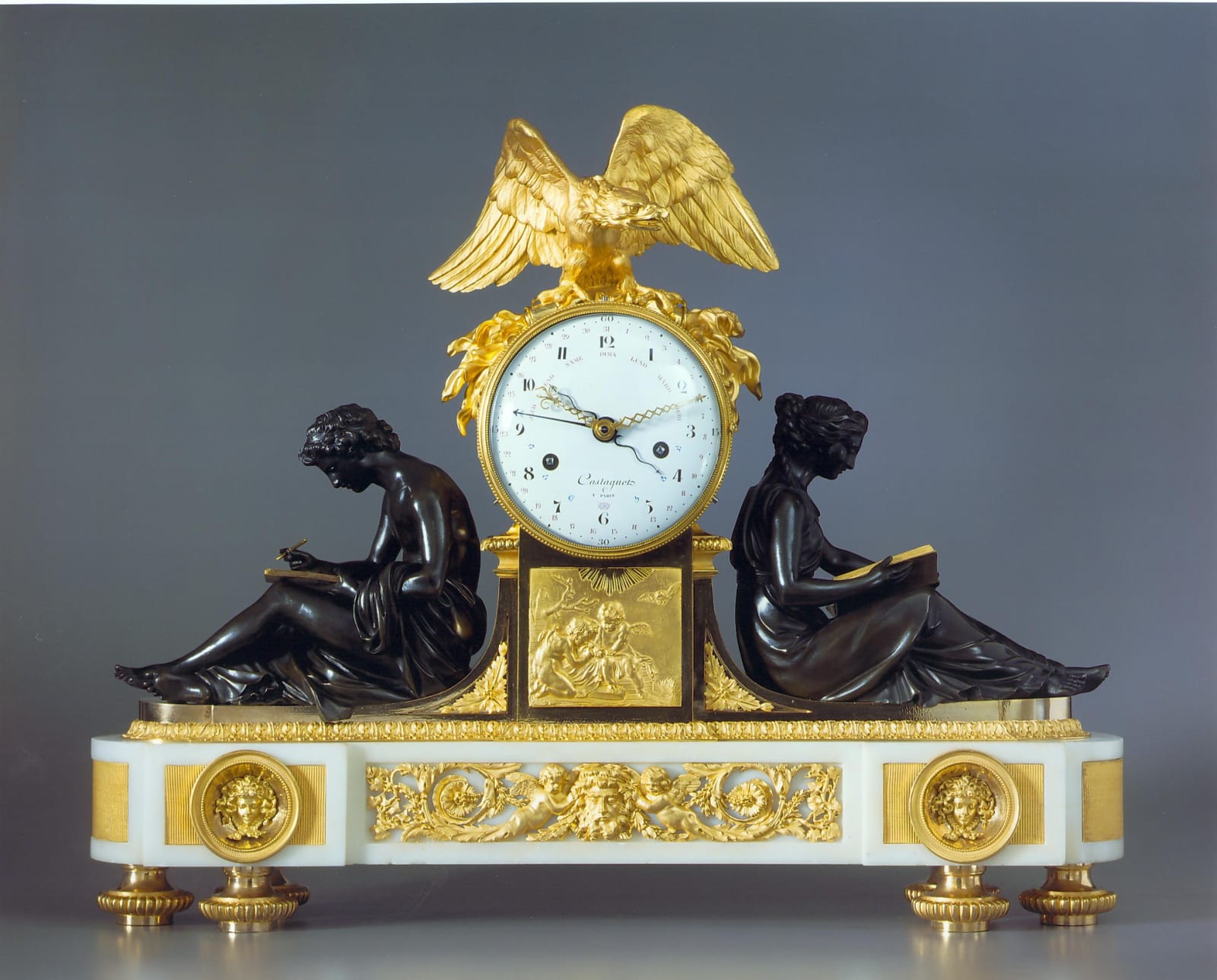Jacques-Joseph Castagnet
Literature
Cedric Jagger, "Royal Clocks", 1983, pp. 154 and 155, illustrating similar clock cases with movements by Lépine and Nicholas Sotiau, in the British Royal Collection.
Hans Ottomeyer and Peter Pröschel, "Vergoldete Bronzen", 1986, p. 295, pl. 4.17.5, illustrating a design for a similar case of 1785 from the Catalogue of François Rémond, and pl. 4.17.6, illustrating an identical case by Rémond.
Jean-Dominique Augarde, "Les Ouvriers du Temps", 1996, p. 206, pl. 168, illustrating a similar clock case by Rémond, signed à Paris on the dial.
Pierre Kjellberg, "Encyclopédie de la Pendule Française du Moyen Age au XXe Siècle", 1997, p. 260, illustrating an identical case with dial signed by the enamellist Dubuisson.
Elke Niehüser, "Die Französische Bronzeuhr", 1997, p. 86, pl. 134, illustrating an identical but slightly later case.
A wonderful Louis XVI patinated and gilt bronze and marble figural clock of eight day duration, signed on the white enamel dial Castagnet à Paris, the finely painted dial with black Arabic numerals for the hours and minutes and red Arabic numerals 1-31 for the days of the month and inner red names and blue symbols for the days of the week, with a very fine pair of pierced gilt brass hands for the hours and minutes and a blued steel pointer and pair of serpentine handles for the calendar indications. The movement with anchor escapement, silk thread suspension, striking on the hour and half hour on a single bell with outside count wheel. The magnificent bronze case with two-toned rose and yellow gilding attributed to François Rémond after models by Louis-Simon Boizot, surmounted by an eagle with thunderbolt striking from under his claws, the dial supported on a gilded pedestal with cast bas-relief depicting two putti with a dove in the manner of Clodion, on either side are two seated patinated bronze classical figures symbolizing Learning and Philosophy, the young man to the left with writing implements and the young woman to the right reading a book, on a rectangular marble base with rounded ends ornamented with a central gilded frieze depicting an Apollo mask bordered by putti and foliate scrolls, with two outer Medusa medallions, supported on six gadrooned feet
Paris, date circa 1790
Height 53 cm, width 69 cm, depth 15 cm.
The design for this celebrated clock case is based on a drawing of circa 1785 attributed to the celebrated ciseleur-doreur François Rémond (b. circa 1747, d. 1812). The two seated figures derive from models by Louis-Simon Boizot (1743-1809) of L’Etude and La Philosophie created in biscuit porcelain for the Sèvres Royal Porcelain Factory, 1780. Rémond was commissioned by the marchand-mercier Dominique Daguerre to execute a clock case of the same design and in 1788 supplied Louis XVI with two clocks of this model for the Salon des Jeux at Saint-Cloud.
Several versions of this clock can be found in important collections including at least three in the British Royal Collection, another at Château Versailles (illustrated in situ in Ottomeyer and Pröschel, op.cit. p. 568, pl. 6). Other examples are owned by the Hermitage Museum at Saint Petersburg, Musée de l’Ile-de-France, Château de Sceaux and at Stockholm Castle. The model enjoyed a revival during the Empire period when Napoleon commissioned a number as gifts for his maréchals.
The movement was supplied by the Parisian clockmaker Jacques-Joseph Castagnet (b. 1729-30 d. 1803-4), who was received as a maître-horloger in 1776. As a mark of his esteem he was appointed a député of his guild 1779-83 and a syndic in 1786, by which date he was recorded as working from rue Saint-Martin. Only a few clocks by Castagnet have been documented, one of which is housed in a Louis XVI pendule ‘à pyramide’, illustrated in P. Kjellberg op.cit. p. 223.
